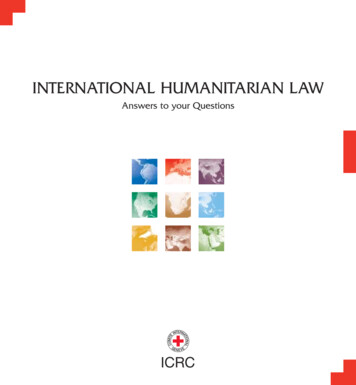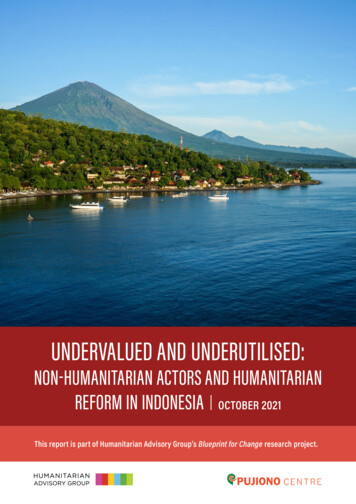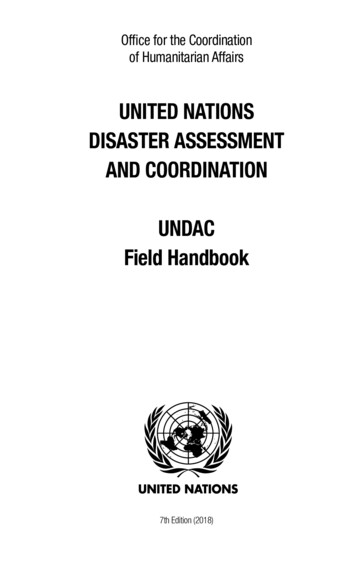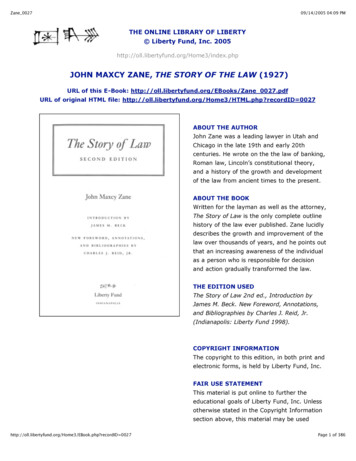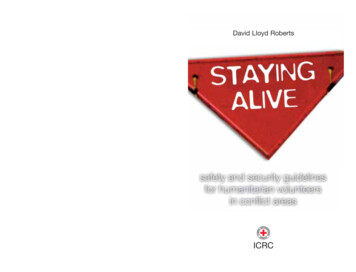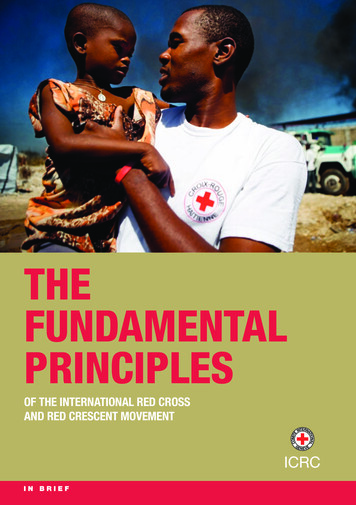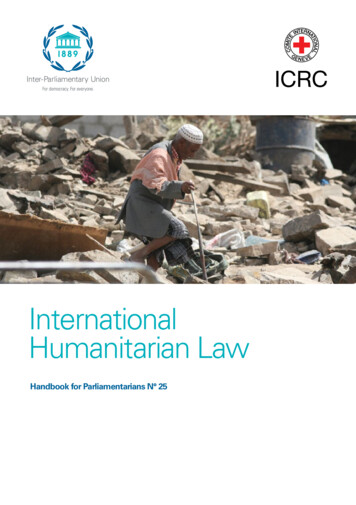
Transcription
InternationalHumanitarian LawHandbook for Parliamentarians N 25
Inter-Parliamentary Union (IPU) and International Committee of the Red Cross (ICRC) 2016This publication is co-published by IPU and the ICRC.For personal and non-commercial use, all or parts of this publication may be reproducedon condition that copyright and source indications are also copied and no modifications aremade. Please inform the Inter-Parliamentary Union on the usage of the publication content.Layout: Ludovica CavallariPrinted by Courand et AssociésISBN: 978-92-9142-656-0 (IPU)Cover photo: Taiz, Yemen. Amidst the destruction, the civilian population struggles tosurvive. Every day brings new challenges and new dangers. ICRC/Anees Mahyoub
ContentsAcknowledgements3Foreword4What does this handbook contain?6Part 1: Q&A about international humanitarian law7What is international humanitarian law?8What are the main IHL treaties and related instruments?12When does IHL apply?17Who does IHL protect and how?21What places and objects does IHL protect and how?27Who is bound by IHL?29How are IHL violations prevented?30How are IHL violations punished?30What is the difference between IHL and IHRL?36Part 2: The role of parliamentarians in implementing IHL39How is IHL implemented?40What measures can parliamentarians take to build a comprehensive national legalframework on IHL?40What practical measures can parliamentarians take to ensure that IHL is implementedat the national level?43What measures can parliamentarians take to ensure that violations of IHL arepunished?49What is the role of parliamentarians in encouraging nationalimplementation of IHL?51What are the other implementing measures provided for by IHL?58What can parliamentarians do to facilitate humanitarian action?60How can parliamentarians reduce vulnerability in conflict-affected States throughflexible, predictable and sustainable funding for humanitarian action?62Part 3: A topic-based approach65IHL and terrorism66Rape and other forms of sexual violence during armed conflicts69Protecting health care in conflict situations72IHL and the challenge of new technologies76Humanitarian activities and the protection of personal data821
Children85Refugees88Internally displaced persons89Missing persons90Persons with disabilities92Private military and security companies93Nuclear weapons95Part 4: Model instruments and reference material97Annex 1: Model instruments of ratification or accessionto international conventions98Annex 2: Model instruments of ratification or accession to IHL treaties99Annex 3: Suggested declarations101Annex 4: Model laws102ICRC and IPU in brief123The ICRC124IPU127Acronyms1282
AcknowledgementsThis handbook is the result of a cooperative effort between the Inter-ParliamentaryUnion (IPU) and the International Committee of the Red Cross (ICRC). Parliamentarianson IPU’s Committee to Promote Respect for International Humanitarian Law also madeimportant contributions.This publication replaces the original handbook, which appeared in 1999. Whilethe structure of the handbook has not changed significantly, the content has beenthoroughly updated in respect of new developments in the field of internationalhumanitarian law.Writing and editorial board:Kareen Jabre and Norah Babic (IPU)Antoine Bouvier (ICRC)Contributors include the following legal advisers at the ICRC: A. Breitegger,T. Ferraro, G. Giacca, L. Gisel, M. Londono, L. Maresca, M. Marelli, M.-J. Eby, C.Pellandini and C. Sabga; and the following members of the ICRC Advisory Service onInternational Humanitarian Law: A. Tobalagba, M. L. Tapp, L. Ladouceur, A. MacKay,C. Apercé and J. Aeschimann3
ForewordIn an increasingly complex world, not only are conflicts more widespread and likely tospill over national borders, but they also exhibit more unconventional forms of violence.As the face and practice of modern warfare is changing dramatically, the need torespect and protect civilians is more urgent than ever.The original Geneva Convention adopted more than 150 years ago was a majorstep forward in protecting sick and wounded combatants. Since then, internationalhumanitarian law (IHL) has grown to include many other treaties and protocols aimedat regulating the conduct of war and limit its effects.Unfortunately, armed conflict is invariably accompanied by terrible human suffering, alltoo often due to violations of IHL. These affect not just belligerents but also civilians,who increasingly bear the brunt of conflict. At times civilians are even specificallytargeted and subjected to horrible atrocities in blatant disregard of the GenevaConventions, whose aim is to protect those not engaged in hostilities.But there is nothing inevitable about this suffering: we have the ability and meansto prevent it. The Geneva Conventions and their Additional Protocols are powerfulmechanisms designed to protect those not, or no longer, engaged in the fighting. In aworld where a dangerous complacency is developing with regard to lack of respect forIHL, the relevance and significance of this body of law have perhaps never been so great.Whilst all countries have ratified the 1949 Geneva Conventions, many have yet toratify or accede to the Additional Protocols of 1977 and other IHL treaties. Universalratification of IHL instruments is a critical first step in making sure those entitled toprotection under the law actually benefit from it.Parliamentarians play a vital role in taking this indispensable first step as well as thesubsequent steps needed to ensure effective implementation. The rules of IHL needto be incorporated into the national legislation and regulations of every country. Thedomestic implementation of IHL treaties is essential to achieving a much greater levelof adherence.Legislation alone is not enough. Through their oversight responsibilities, parliaments andparliamentarians can ensure the military and security forces are properly trained andknowledgeable on IHL. Through their leadership and advocacy, they can also raise greaterawareness of IHL among the public. If the concepts underpinning IHL are known andunderstood in peacetime, they are more likely to be applied in wartime.This handbook is the most recent outcome of many fruitful years of cooperation andpartnership between the Inter-Parliamentary Union (IPU) and the International Committeeof the Red Cross (ICRC), the guardian and promoter of IHL. It is specially designed tofamiliarize parliamentarians with the general principles of the Geneva Conventions andtheir Additional Protocols and guide them in the process of implementing this body4
of law in their respective country. The handbook provides step-by-step information onmeasures that States party to the Geneva Conventions must take to fulfil the obligationsthey have accepted to “respect and ensure respect” for IHL.This is a highly politicized area in which parliamentarians, as political leaders andrepresentatives of the people, must be in the vanguard of efforts to ensure IHL isfaithfully applied.This handbook is also intended to help parliamentarians in countries that are not yetparty to all IHL treaties to convince their government leaders of the absolute need toprotect civilians caught up in conflict and ensure perpetrators of war crimes are heldaccountable for their actions.Victims of war the world over are a daily reminder that the responsibility to protect themost vulnerable people and to end human suffering is a collective one. The power ofthe world’s parliaments to effect global change through individual national action is animmense one. This handbook is intended to help them put that power to use.Martin ChungongSecretary GeneralInter-Parliamentary UnionPeter MaurerPresidentInternational Committee of the Red Cross5
What does this handbook contain?Part 1 offers a general overview of international humanitarian law (IHL) throughan analysis of nine general questions. It addresses the sources of IHL; the situationsin which it applies; the categories of people protected by its rules; mechanisms forimplementing IHL and suppressing violations thereof; and the link between IHL andother branches of international law.Part 2 is entirely devoted to the role of parliamentarians in implementing IHL. Itreviews the different types of measures parliamentarians should consider to improveStates’ respect for IHL. These measures seek to prevent violations of the obligationsaccepted by States; improve oversight regarding application of the rules; and punishthose who are responsible for violations of the rules. Each of these measures isaccompanied by a detailed checklist for the parliamentarians.Part 3 contains an overview of some key issues that are prevalent in today’s armedconflicts, ranging from acts of terrorism to sexual violence and from the use of newtechnologies to the protection of the personal data of victims of armed conflict.Part 4 provides a number of model instruments and reference materials. Theseresources can help parliamentarians in their efforts to have their country accede to IHLtreaties and to carry out the legislative work necessary to properly apply and enforcethese treaties domestically.Part 5 describes the work of IPU and the ICRC in further detail.6
Part 1: Q&A about internationalhumanitarian lawAnayancy Prison, Quibdo, Colombia. Private interview with detainee. ICRC/ Boris Heger7
What is international humanitarian law?International humanitarian law (IHL), sometimes called the“law of war” or “law of armed conflict,” regulates relationsbetween States, international organizations and othersubjects of international law in times of armed conflict. Itis a branch of public international law that consists of rulesaimed at protecting people who are not or are no longerparticipating in the hostilities and at restricting the meansand methods of warfare. In other words, IHL consistsof international treaty law and customary rules that arespecifically meant to resolve humanitarian issues arisingdirectly from armed conflict, whether of an international ora non-international character.The seven fundamental rules underpinning the 1949Geneva Conventions and their Additional Protocolsof 1977 and 200581.People who are hors de combat and those whodo not take a direct part in hostilities are entitledto respect for their lives and their moral andphysical integrity. They shall in all circumstancesbe protected and treated humanely without anyadverse distinction.2.It is forbidden to kill or injure an enemy whosurrenders or who is hors de combat.3.The wounded and sick shall be collected andcared for by the party to the conflict which hasthem in its power. Protection also covers medicalpersonnel, facilities, transports and equipment.The red cross and red crescent emblems are thesigns of such protection and must be respected.4.Captured combatants and civilians under theauthority of an adverse party are entitled torespect for their lives, dignity, personal rights andconvictions. They shall be protected against all actsof violence and reprisals. They shall have the right tocorrespond with their families and to receive relief.5.Everyone shall be entitled to benefit fromfundamental judicial guarantees. No one shallbe held responsible for an act he or she has notcommitted. No one shall be subjected to physicalor mental torture, corporal punishment or cruel ordegrading treatment.IHL has two branches:The “law of Geneva”:the body of rules thatprotects victims ofarmed conflict, suchas military personnelwho are hors decombat (such aswounded combatantsand prisoners of war)and civilians who arenot or are no longerdirectly participating inhostilities.The “law of TheHague”: the body ofrules establishing therights and obligationsof belligerents in theconduct of hostilities,and which limits themeans and methods ofwarfare.
6.Parties to a conflict and members of their armed forces do not have anunlimited choice of methods and means of warfare. It is prohibited to employweapons or methods of warfare which are of a nature to cause superfluousinjury or unnecessary suffering.7.Parties to a conflict shall at all times distinguish between the civilian populationand combatants in order to spare civilians and civilian property. Attacks shall bedirected solely against military objectives.IHL does not determine whether a State has a right to wage war or use armedforce against another State. That question is governed by a distinct branch of publicinternational law called jus ad bellum and set out in the United Nations Charter. IHL,on the other hand, is synonymous with jus in bello. This latter body of law regulatesthe behaviour of parties engaged in an armed conflict, regardless of the reasons for theconflict or of which party started the hostilities. It is also designed to protect victims ofarmed conflict, regardless of their loyalties.Jus ad bellumJus in belloDetermines the right to resort to armedforce.Applies to all parties and governs theirbehaviour once an armed conflict hasbroken out.Making war illegalArticle 2(4) of the United NationsCharter states that “[a]ll Members shallrefrain in their international relationsfrom the threat or use of force againstthe territorial integrity or politicalindependence of any state”. In otherwords, war is not an acceptable meansof settling disputes between States.War is a realityIHL applies irrespective of the reasonsfor the conflict and the validity of itsunderlying causes.The Charter nevertheless makes twoexceptions to this rule: for cases of individual or collectiveself-defence in response toaggression by another State orgroup of States; and upon authorization by the UNSecurity Council (acting on thebasis of Chapter VII of the Charter)in order to maintain internationalpeace and security.The prohibition against the use of forcedoes not apply to non-international armedconflicts.9
Striking a balance between military necessity and humanityIHL is a compromise between two underlying principles: military necessity andhumanity. These two principles shape all its rules.According to the principle of military necessity, parties to a conflict may only resortto those means and methods that are necessary to achieve the legitimate militarypurpose of a conflict and that are not otherwise prohibited by IHL. The degree and kindof force that the parties can use is therefore limited to what is needed to overcome theenemy as quickly as possible with the smallest loss of life and resources.The principle of humanity forbids the parties to a conflict to cause any suffering ordestruction that is not required to achieve the legitimate purpose of a conflict.Distinction, proportionality and precautionIHL seeks to protect civilians in times of conflict by regulating the conduct of hostilities,i.e. how the parties to an armed conflict carry out their military operations. It draws onthree principles:Distinction: The parties must distinguish at all times between civilians and civilianobjects on one hand, and combatants and military objectives on the other. In otherwords, a party to an armed conflict may only direct its attacks against combatants andmilitary objectives. Direct attacks against civilians and civilian objects are prohibited.Indiscriminate attacks are also prohibited; they refer to attacks that are not directedat a specific military objective, employ a method or means of warfare that cannot bedirected at a specific military objective, or employ a method or means of combat theeffects of which cannot be limited as required by IHL.Proportionality: Injury to civilians and the incidental loss of civilian life and propertyshould not be excessive in relation to the concrete and direct military advantageanticipated by an attack.Precaution: The parties must take constant care to spare civilians and civilian objectsduring military operations. This can include double-checking that a target is indeed amilitary objective or effectively warning the civilian population before an attack.Prohibitions and restrictions on certain means and methods of warfareGeneral prohibitions and restrictionsIHL prohibits means (weapons) and methods of warfare that:10 are designed mainly to spread terror among the civilian population; do not distinguish between combatants and civilians (and their property); cause superfluous injury or unnecessary suffering; cause severe and long-term damage to the natural environment.
Specific prohibitions and restrictionsThe use of some weapons is restricted or completely prohibited under treaty andcustomary IHL, including: poison and poisonous weapons; chemical and biological weapons; bullets that spread or explode within the body (dum-dum bullets); weapons whose primary effect is to injure by fragments that cannot bedetected by X-rays; explosive and inflammable projectiles; mines, booby-traps and similar devices; incendiary weapons and weapons that are primarily designed to burn objects orpeople; blinding laser weapons; explosive remnants of war; anti-personnel mines; cluster munitions.The 2013 Arms Trade Treaty prohibits a State from authorizing any transfers ofconventional arms, their key components and ammunition if it has knowledge thatthey would be used in the commission of genocide, crimes against humanity, gravebreaches of the Geneva Conventions, attacks directed against civilian objects orcivilians protected as such, or other war crimes. It also requires an exporting State toconduct a risk assessment as to whether such weapons or items could be used tocommit or facilitate a serious violation of IHL or international human rights law (IHRL).Some methods of warfare are specifically prohibited under treaty and customary IHL,including: denying quarter: an adversary’s forces must be given an opportunity tosurrender and be taken prisoner; pillaging private property; starving the civilian population; and resorting to perfidy to kill, injure or capture an adversary. Perfidy is defined inArticle 37 of Additional Protocol I as“acts inviting the confidence of an adversaryto lead him to believe that he is entitled to, or is obliged to accord, protectionunder the rules of international law applicable in armed conflict, with intent tobetray that confidence”. This includes, for instance feigning injury or sickness inorder to attack an enemy.11
What are the main IHL treaties and relatedinstruments?Treaties on protecting victims of armed conflictConvention for the Amelioration of the Protects wounded and sick combatants,Condition of the Wounded and Sick in the personnel attending them, theArmed Forces in the Fieldbuildings in which they are shelteredand the equipment including means of(First Geneva Convention)transportation used for their benefit.12 August 1949Convention for the Amelioration ofthe Condition of Wounded, Sick andShipwrecked Members of ArmedForces at SeaRegulates the use of the red cross, redcrescent and red crystal emblems.Extends protection to shipwreckedcombatants and regulates how they areto be treated.(Second Geneva Convention)12 August 1949Convention relative to the Treatmentof Prisoners of War(Third Geneva Convention)12 August 1949Convention relative to the Protectionof Civilian Persons in Time of War(Fourth Geneva Convention)12 August 1949Protocol Additional to the GenevaConventions of 12 August 1949, andrelating to the Protection of Victims ofInternational Armed Conflicts(Additional Protocol I)8 June 197712Protects members of the armed forceswho have been taken prisoner. Setsforth the detaining power’s rights andobligations, including how prisoners areto be treated.Establishes the rules governing theprotection of the civilian population, inparticular the treatment of civilians inoccupied territory and those deprivedof their liberty, and the question ofoccupation in general.Contains fundamental guarantees forpeople not taking part in hostilities duringan international armed conflict and setsforth rules on protecting civilians, civilianobjects and the installations essential forcivilians’ survival.
Protocol Additional to the GenevaConventions of 12 August 1949, andrelating to the Protection of Victims ofNon-International Armed Conflicts(Additional Protocol II)Contains fundamental guarantees forpeople not taking part in hostilities duringa non-international armed conflict andsets forth rules on protecting civilians,civilian objects and the installationsessential for civilians’ survival.8 June 1977Protocol Additional to the GenevaConventions of 12 August 1949,and relating to the Adoption of anAdditional Distinctive EmblemAdds the red crystal to the red cross andred crescent as distinctive emblems.(Additional Protocol III)8 December 2005Convention on the Rights of the Child20 November 1989Article 38 expands the protection ofchildren in situations of armed conflict.Article 43 envisions a committeethat would be created to monitor thesignatory States’ progress on theirobligations under the Convention.Optional Protocol to the Conventionon the Rights of the Child on theInvolvement of Children in ArmedConflict25 May 2000Requires States Parties to refrain fromforcibly recruiting children under the ageof 18 in their armed forces and to ensurethat any member of their armed forcesunder the age of 18 does not take adirect part in hostilities.Calls on non-State armed groups toabstain from recruiting or using childrenunder the age of 18 in hostilities.International Convention for theProtection of All Persons fromEnforced DisappearanceSeeks to ensure that people do not gomissing, including in situations of armedconflict.20 December 2006Treaties restricting the use of or prohibiting certain weaponsProtocol for the Prohibition of the Useof Asphyxiating, Poisonous or OtherGases, and of Bacteriological Methodsof WarfareProhibits the use of asphyxiating,poisonous and other gases, and ofliquids, materials and devices of thatnature.17 June 192513
Convention on the Prohibitionof the Development, Productionand Stockpiling of Bacteriological(Biological) and Toxin Weapons and ontheir DestructionProhibits the development, production,stockpiling, acquisition and retention ofmicrobial agents, other biological agentsand toxins that have no justification forpreventive, protective or other peacefulpurposes.10 April 1972Also prohibits weapons, equipment andmeans of delivery designed to use suchagents or toxins for hostile purposes or inarmed conflict.Convention on Prohibitions orRestrictions on the Use of CertainConventional Weapons which May BeDeemed to Be Excessively Injurious orto Have Indiscriminate Effects (CCW)Establishes the framework for prohibitingcertain weapons (see the conventionprotocols below).10 October 1980, amended on 21December 2001CCW Protocol on Non-DetectableFragments (Protocol I)10 October 1980Prohibits the use of weapons that injureby fragments that cannot be detected byX-rays.CCW Protocol on Prohibitions orRestrictions on the Use of Mines,Booby-Traps and Other Devices(Protocol II)Prohibits the use of mines, booby-trapsand other devices against the civilianpopulation and restricts their use againstmilitary targets.10 October 1980, amended on 3 May1996The amended protocol further extendsthe prohibition of those devices andextends its scope to non-internationalconflicts.CCW Protocol on Prohibitions orRestrictions on the Use of IncendiaryWeapons (Protocol III)Prohibits the use of incendiary weaponsagainst civilians and civilian objectsand restricts their use against militarytargets.10 October 1980CCW Protocol on Blinding LaserWeapons (Protocol IV)13 October 199514Prohibits the use of laser weaponsthat are specifically designed to causepermanent blindness.
CCW Protocol on Explosive Remnantsof War (Protocol V)28 November 2003Convention on the Prohibition of theDevelopment, Production, Stockpilingand Use of Chemical Weapons and ontheir DestructionMakes States Parties as well as nonState actors responsible for explosiveremnants of war in territory under theircontrol, and urges users of explosiveordnance to provide assistance tofacilitate the marking and clearance,removal or destruction of explosiveremnants of war.Prohibits the development, production,stockpiling and use of chemical weapons.13 January 1993Convention on the Prohibition ofthe Use, Stockpiling, Production andTransfer of Anti-Personnel Mines andon their DestructionProhibits the use, stockpiling, productionand transfer of anti-personnel mines (landmines).18 September 1997Convention on Cluster Munitions30 May 2008Arms Trade Treaty2 February 2013Prohibits the use, development,production, acquisition, stockpiling,retention and transfer of clustermunitions and any assistance orencouragement to engage in activitiesbanned by the convention.Regulates international transfers ofconventional weapons, ammunition,munitions, parts and components.Treaties on protecting cultural property and the environmentConvention for the Protection ofCultural Property in the Event ofArmed Conflict14 May 1954First Protocol to the HagueConvention of 1954 for the Protectionof Cultural Property in the Event ofArmed ConflictProtects cultural property, includingworks of architectural, artistic orhistorical significance; applies also tonon-international conflicts.Seeks to prevent the exportationof cultural property from occupiedterritory and to ensure such property issafeguarded and returned.14 May 195415
Second Protocol to the HagueConvention of 1954 for the Protectionof Cultural Property in the Event ofArmed ConflictExpands the rules protecting culturalproperty and strengthens enforcementmechanisms; applies also to noninternational conflicts.26 March 1999Convention on the Prohibition ofMilitary or Any Other Hostile Use ofEnvironmental Modification Techniques10 December 1976Prohibits the use, for military or otherhostile purposes, of environmental orgeophysical modification techniqueshaving widespread, lasting or severeeffects.International criminal justiceStatute of the International CriminalCourt (ICC Statute)17 July 1998, amended on 11 June 2010(Kampala Amendments)Do you want to learnmore about IHLtreaties and relatedinstruments?Contact the ICRCdirectly or consultthe ICRC’s Treatiesand Customary Lawwebpage: mary-law.Interested in whetheryour State has signeda given treaty?Contact the depositoryState or the ICRC,or consult its treatydatabase (https://www.icrc.org/ihl).1116Establishes a permanent internationalcriminal court with jurisdiction overgenocide, war crimes, crimes againsthumanity and the crime of aggression.1What is customary IHL?IHL is developed by States through both treatiesand customary law. Customary law is formed whenState practice is sufficiently dense (widespread,representative, frequent and uniform) and accompaniedby a belief (the opinio juris) among States that theyare legally bound to act – or prohibited from acting – incertain ways. Custom is binding on all States exceptthose that have persistently objected to a given practiceor rule since its inception.The links between treaty law and customary law arenumerous and complex. Many provisions of the treatieslisted above are recognized as having originated in thesphere of customary law, and a number of provisionsthat represented new developments when they wereadopted as treaty provisions have progressively acquiredcustomary value. In addition, many treaty provisionsthat were initially supposed to apply only in internationalarmed conflicts are now considered to be applicable inall types of armed conflicts as customary law.The ICC’s jurisdiction over the crime of aggression will not take effect until the States Parties activate it, which can happen from 1January 2017.
Interested in finding out more?In 1995, the ICRC embarked on a detailed study of the customary rules of IHL. The study,which took ten years to complete, can be consulted on the ICRC website: https://www.icrc.org/customary-ihl.When does IHL apply?IHL applies only in situations of armed conflict. It offerstwo systems of protection: one for international armedconflict and another for non-international armed conflict.The rules applicable in a specific situation will thereforedepend on the classification of the armed conflict. IHLdoes not apply to situations of violence that do not amountto armed conflict; these are termed internal disturbancesand tensions and are governed by human rights law anddomestic legislation.International armed conflicts (IACs) are those in whichone or more States resort to the use of armed force againstanother State or States. The rules applicable in internationalarmed conflicts also apply during: an armed conflict between one or more States andan international organization (i.e. a multinationalforce); a war of national liberation (under certain conditions); and occupation.What are internaldisturbances andtensions?Internal disturbancesand tensions (suchas riots and isolatedand sporadic actsof violence) disruptpublic order withoutamounting to armedconflict; they cannotbe regarded as armedconflicts because thelevel of violence isnot sufficiently high orbecause the individualsresorting to violenceare not organized as anarmed group.Non-international armed conflicts (NIACs) are conflicts that take place within theterritory of a single State between governmental armed forces and one or more non-Statearmed groups, or between such groups themselves. Many armed conflicts today are noninternational in nature. For hostilities to be considered a NIAC, they must reach a certainlevel of intensity and the groups involved must be sufficiently organized.Which law applies?The rules that apply to a specific conflict depend on whether it is international ornon-international. International armed conflicts are subject to a broad range of rules,including those set forth in the four Geneva Conventions and Additional Protocol I.A more limited set of rules applies to non-international armed conflicts. They are laid outin Article 3 common to the four Geneva Conventions and in Additi
This handbook is the result of a cooperative effort between the Inter-Parliamentary Union (IPU) and the International Committee of the Red Cross (ICRC). Parliamentarians on IPU’s Committee to Promote Respect for International Humanitarian Law also made important contributions. This publication replaces the
